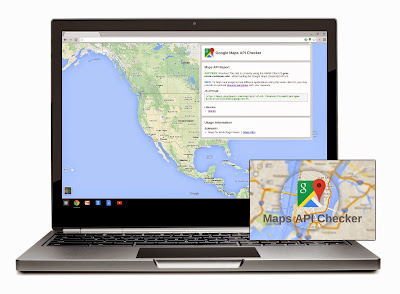Cross-posted from Google Developers Blog
Posted by Ian Lake, Developer Advocate
To offer more seamless integration of Google products within your app, we’re excited to start the rollout of the latest version of Google Play services.
Google Play services 6.5 includes new features in Google Maps, Google Drive and Google Wallet as well as the recently launched Google Fit API. We are also providing developers with more granular control over which Google Play services APIs your app depends on to help you maintain a lean app.
Google Maps
We’re making it easier to get directions to places from your app! The Google Maps Android API now offers a map toolbar to let users open Google Maps and immediately get directions and turn by turn navigation to the selected marker. This map toolbar will show by default when you compile against Google Play services 6.5.
In addition, there is also a new ‘lite mode’ map option, ideal for situations where you want to provide a number of smaller maps, or a map that is so small that meaningful interaction is impractical, such as a thumbnail in a list. A lite mode map is a bitmap image of a map at a specified location and zoom level.
In lite mode, markers and shapes are drawn client-side on top of the static image, so you still have full control over them. Lite mode supports all of the map types, the
My Location layer, and a subset of the functionality of a fully-interactive map. Users can tap on the map to launch Google Maps when they need more details.
The Google Maps Android API also exposes a new
getMapAsync(OnMapReadyCallback) method to
MapFragment and
MapView which will notify you exactly when the map is ready. This serves as a replacement for the now deprecated
getMap() method.
We’re also exposing the Google Maps for Android app intents available to your apps including displaying the map, searching, starting turn by turn navigation, and opening Street View so you can build upon the familiar and powerful maps already available on the device.
Drive
You can now add both public and application private custom file properties to a Drive file which can be used to build very efficient search queries and allow apps to save information which is guaranteed to persist across editing by other apps.
We’ve also made it even easier to make syncing your files to Drive both user and battery friendly with the ability to control when files are uploaded by network type or charging status and cancel pending uploads.
Google Wallet
In addition to the existing ‘Buy with Google’ button available to quickly purchase goods & services using Google Wallet, this release adds a ‘Donate with Google’ button for providing the same ease of use in collecting donations.
Google Fit
The Google Fit SDK was recently
officially released as part of Google Play services and can be used to super-charge your fitness apps with a simple API for working with sensors, recording activity data, and reading the user’s aggregated fitness data.
In this release, we’ve made it easier for developers to add activity segments (predefined time periods of running, walking, cycling, etc) when inserting
sessions, making it easy to support pauses or multiple activity type workouts. We’ll also be adding additional samples to help kick-start your Google Fit integration.
Granular Dependency Management
As we’ve continued to add more APIs across the wide range of Google services, it can be hard to maintain a lean app, particularly if you're only using a portion of the available APIs. Now with Google Play services 6.5, you’ll be able to depend only on a minimal common library and the exact APIs your app needs. This makes it very lightweight to get started with Google Play services.
SDK Coming Soon!
We’ll be rolling out Google Play services 6.5 over the next few days, and we’ll update this blog post, publish the documentation, and make the SDK available once the rollout completes.
To learn more about Google Play services and the APIs available to you through it, visit the
Google Play Services section on the Android Developer site.




